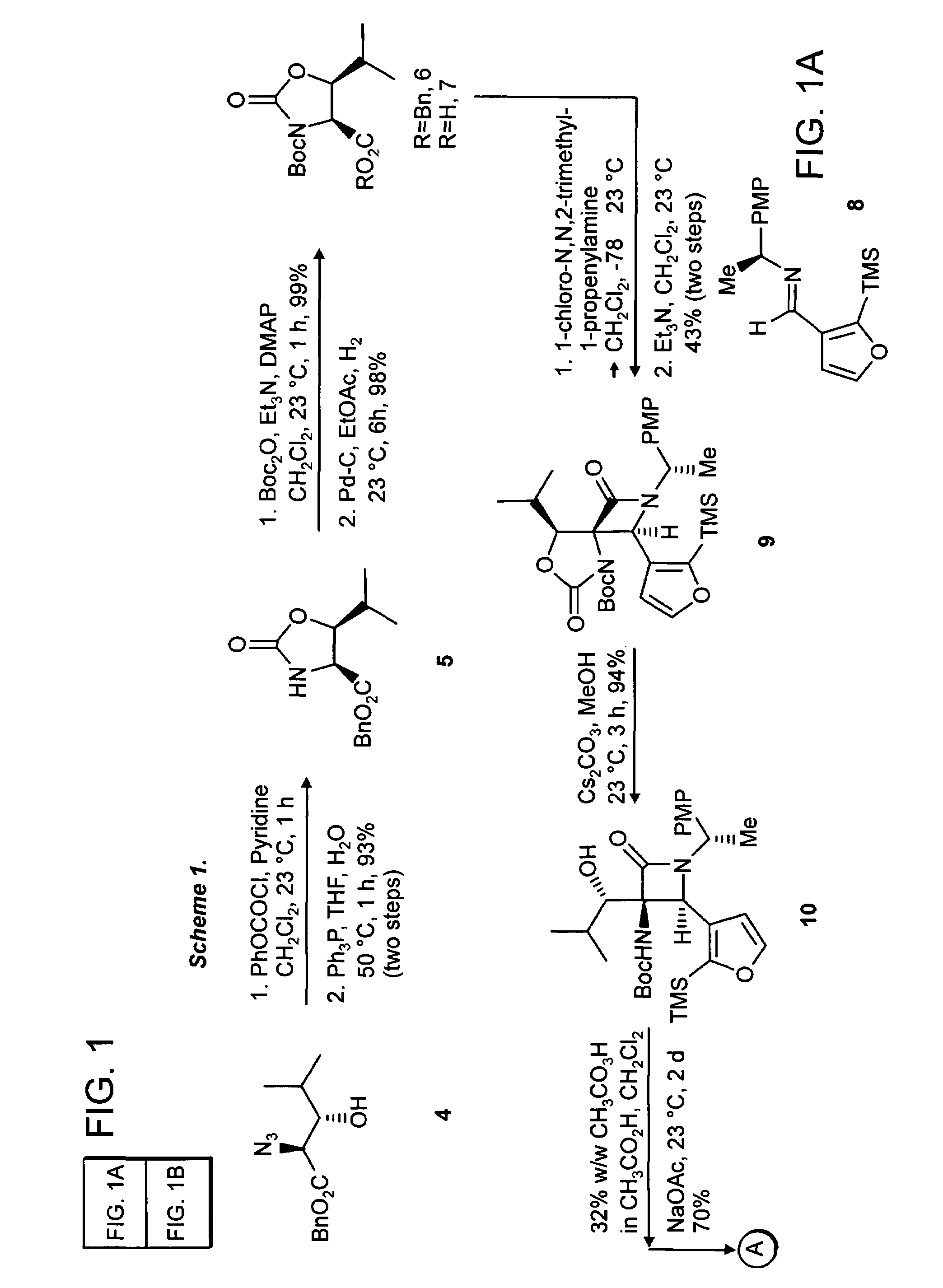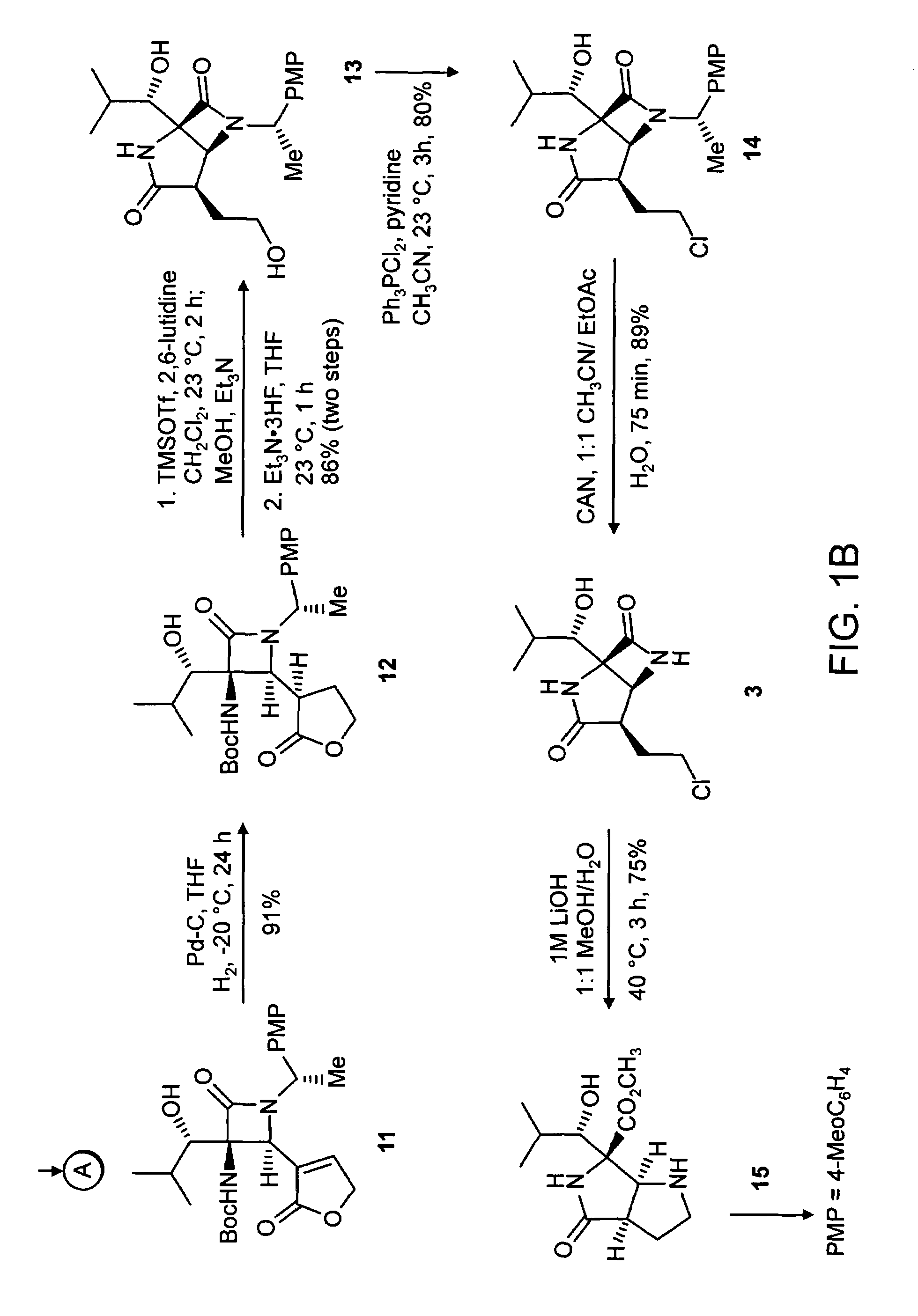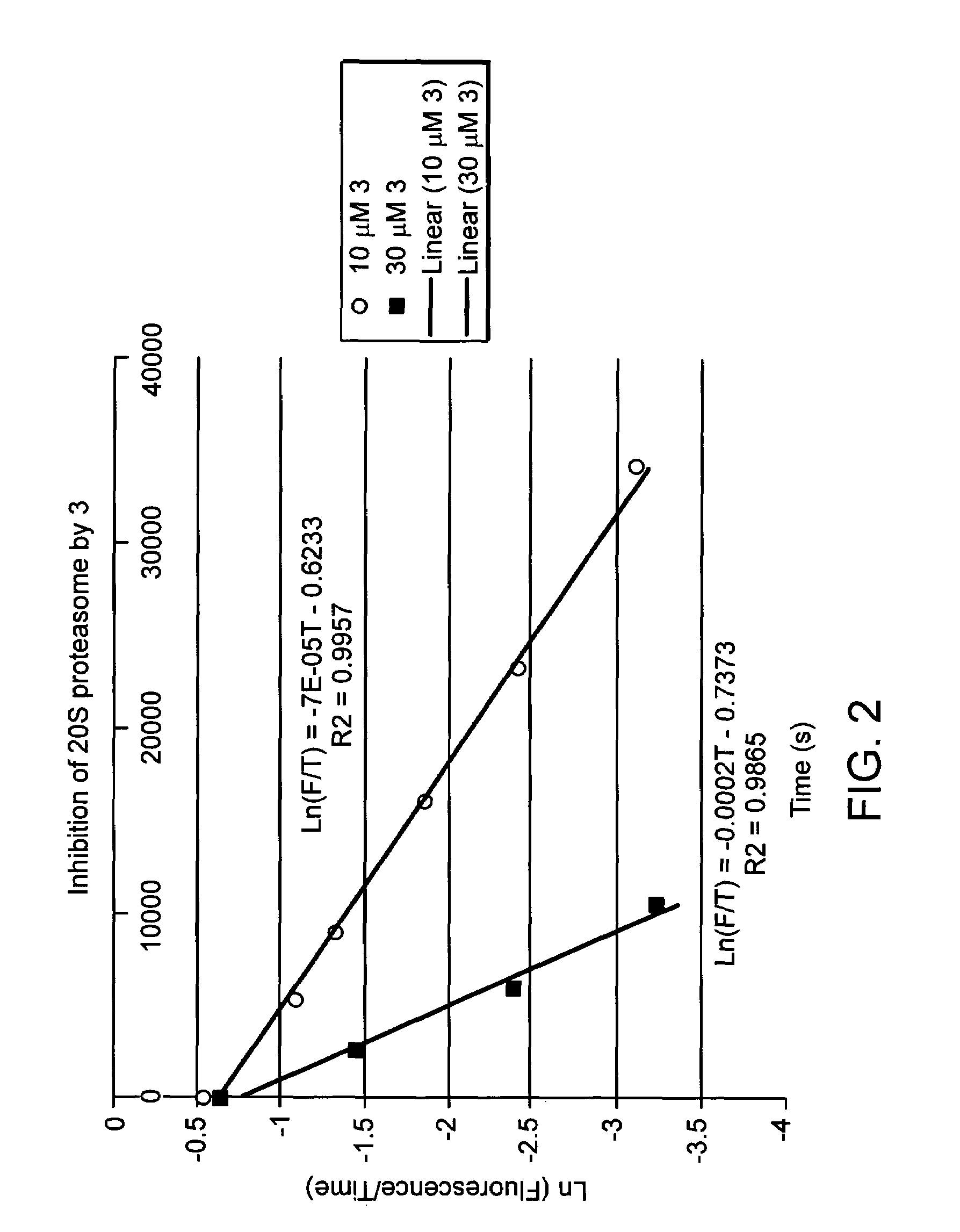Proteasome inhibiting beta-lactam compounds
a technology of beta-lactam and proteasome, which is applied in the direction of biocide, organic chemistry, drug compositions, etc., can solve the problems of short half-life in solution at ph 7 or in serum
- Summary
- Abstract
- Description
- Claims
- Application Information
AI Technical Summary
Problems solved by technology
Method used
Image
Examples
example 1
[0080]
[0081](4S,5S) 5-Isopropyl-2-oxo-oxazolidine-4-carboxylic acid benzyl ester (Compound 5). To a solution of the azide, Compound 4 (prepared essentially by the method of Hruby et al., J. Org. Chem. 2002, 67, 3514-3517) (2.0 g, 7.6 mmol, 1 equiv) in dichloromethane at 23° C. (20 mL), was added pyridine (920 μL, 11.5 mmol, 2.5 equiv), followed by phenyl chloroformate (1.05 mL, 8.35 mmol, 1.1 equiv). After 1 h the resulting suspension was partitioned between dichloromethane (50 ml) and aqueous hydrochloric acid (2N, 50 mL). The organics were dried over sodium sulfate and concentrated in vacuo. To the resultant residue was added THF (20 mL), water (2 mL) and triphenylphosphine (2.2 g, 8.35 mmol, 1.1 equiv). The resulting solution was heated to 50° C. for 1 h, during which time gas evolution was observed. The reaction was diluted with dichloromethane (100 mL) and sodium sulfate was added to the resultant solution. The organics were filtered and concentrated in vacuo. The residue was p...
example 2
[0082]
[0083](4S,5S) 5-Isopropyl-2-oxo-oxazolidine-3,4-dicarboxylic acid 4-benzyl ester 3-tertbutyl ester (Compound 6). To a solution of the oxazolidinone 5 (1.85 g, 7.1 mmol, 1 equiv) in dichloro-methane (20 mL) was added triethylamine (1.5 mL, 10.1 mmol, 1.5 equiv), di-tent-butyl dicarbonate (1.69 g, 7.8 mmol, 1.1 equiv) and 4-dimethylaminopyridine (86 mg, 710 μmol, 0.1 equiv). The resultant mixture was allowed to stir at 23° C. for 1 h. The reaction was concentrated in vacuo. The residue was purified by flash chromatography on silica gel (35% ethyl acetate in hexanes) to give 6 (2.56 g, 7.05 mmol, 99%) as a colorless solid mp 114-115° C., Rf=0.39 (25% ethyl acetate in hexanes), [α]23D−38.4 (c 0.95, CHCl3); FTIR (neat), cm−1: 2891, 2937, 1825, 1746, 1727, 1358, 1212, 1075; 1H NMR (500 MHz, CDCl3), δ: 7.36 (m, 5H), 5.23 (d, 1H, J=12.5 Hz), 5.19 (d, 1H, J=12.5 Hz), 4.71 (d, 1H, J=7.5 Hz), 4.13 (dd, 1H, J=7, 5 Hz), 1.64 (m, 1H), 1.41 (s, 9H0, 1.01 (d, 3H, J=6.5 Hz), 0.93 (d, 3H, J=6.5...
example 3
[0084]
[0085](4S,5S) 5-Isopropyl-2-oxo-oxazolidine-3,4-dicarboxylic acid 3-tert-butyl ester (Compound 7). To a solution of the benzyl ester 6 (2.56 g, 7.05 mmol, 1 equiv) in ethyl acetate (100 mL) was added 10% Pd on carbon (500 mg), and the solution was placed under a balloon atmosphere of hydrogen. The suspension was stirred for 6 h, at which time the suspension was filtered through Celite and concentrated in vacuo to give the acid 7 (1.38 g, 6.91 mmol, 98%) as a colorless solid mp 120-122° C., Rf=0.2 (50% ethyl acetate in hexanes), [α]23D−24.7 (c 0.97, CHCl3; FTIR (neat), cm−1: 3502, 3205, 2981, 1806, 1729, 1368, 1216; 1H NMR (500 MHz, CDCl3), δ: 4.74 (d, 1H, J=7 Hz), 4.19 (dd, 1H, J=7.5, 5 Hz), 1.90 (m, 1H), 1.521 (s, 9H), 1.01 (d, 3H, J=6 Hz), 1.06 (d, 3H, J=6 Hz); 13C NMR (100 MHz, CDCl3), δ: 171.9, 151.9, 85.0, 80.6, 60.6, 29.0, 27.7, 19.0, 18.3; LRMS Calcd for C12H19NO6 [M]+ 273.1. Found [M+NH4]+291.2.
PUM
| Property | Measurement | Unit |
|---|---|---|
| pH | aaaaa | aaaaa |
| particle size | aaaaa | aaaaa |
| pH | aaaaa | aaaaa |
Abstract
Description
Claims
Application Information
 Login to View More
Login to View More - R&D
- Intellectual Property
- Life Sciences
- Materials
- Tech Scout
- Unparalleled Data Quality
- Higher Quality Content
- 60% Fewer Hallucinations
Browse by: Latest US Patents, China's latest patents, Technical Efficacy Thesaurus, Application Domain, Technology Topic, Popular Technical Reports.
© 2025 PatSnap. All rights reserved.Legal|Privacy policy|Modern Slavery Act Transparency Statement|Sitemap|About US| Contact US: help@patsnap.com



